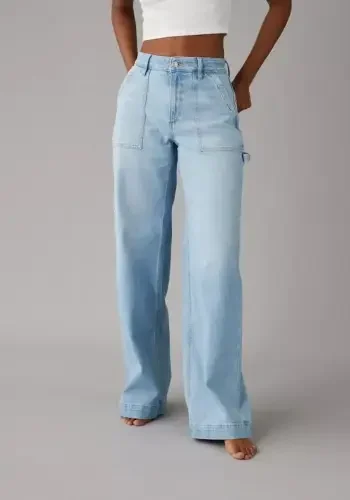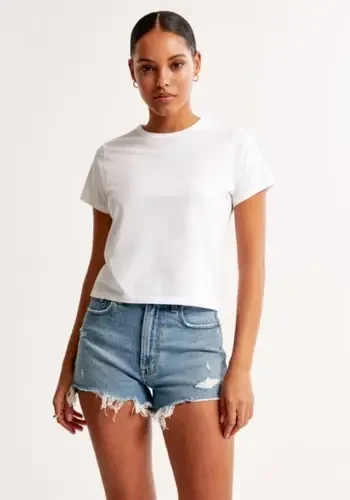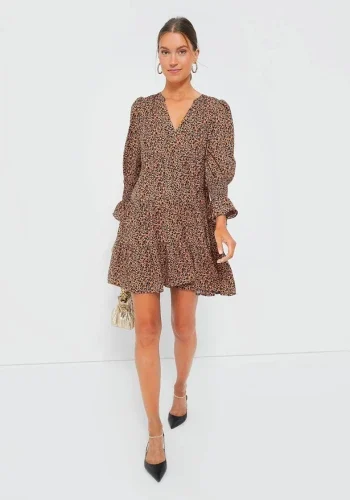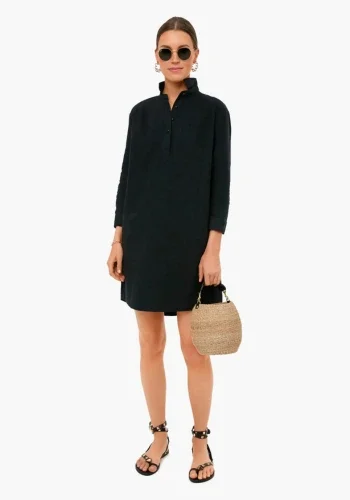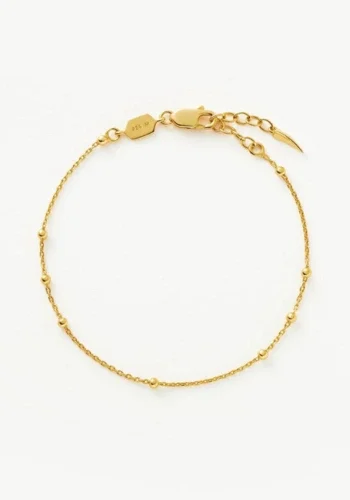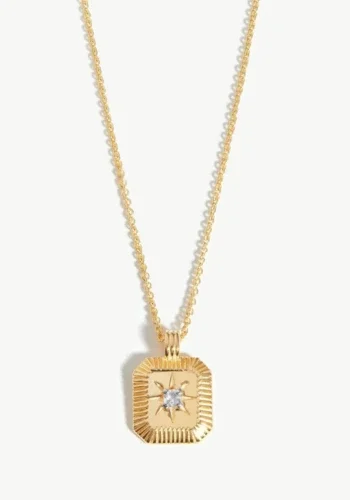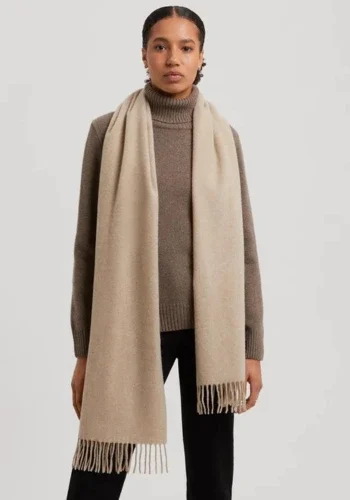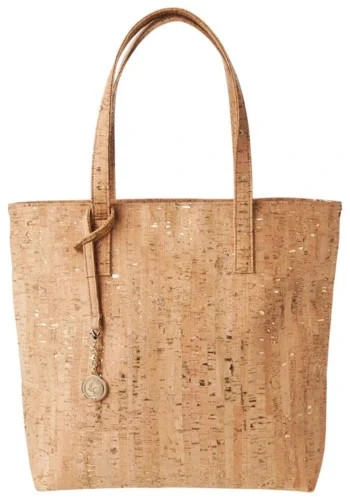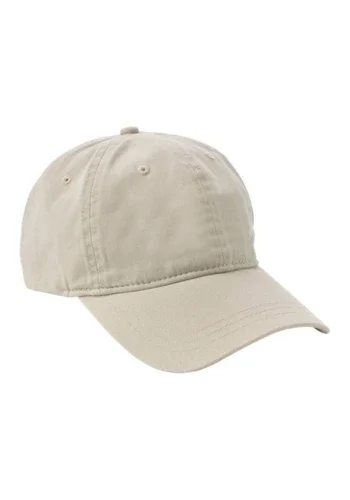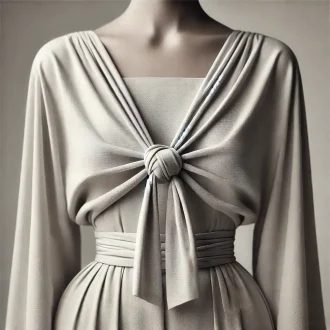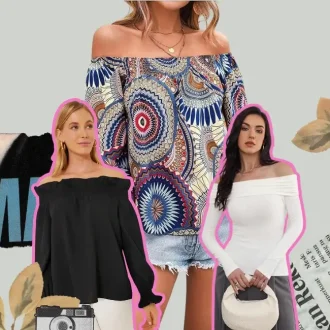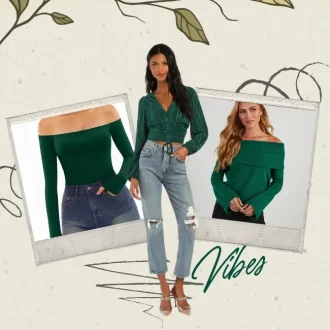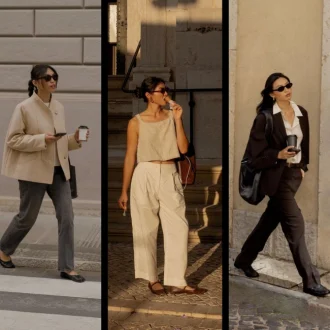- IN THIS ARTICLE
Embracing the casual dress code is about blending comfort with style, a mantra for the modern woman.
In this guide, we delve into the essentials of casual chic, from picking the right pieces to accessorizing with ease.
Whether you’re updating your wardrobe or seeking tips for different occasions, we’ve got practical, stylish advice to make casual dressing effortlessly elegant.
Let’s unlock the secrets to mastering casual style, tailored just for you.
What is a Casual Dress Code?
A casual dress code is all about comfort and simplicity. It’s the kind of clothing you’d wear on a regular day, where there’s no need to dress up for an event or a formal meeting. Think of what you’d wear to a casual coffee date with friends or a relaxed day at home. This style is not about making a fashion statement, but about feeling good and at ease in what you’re wearing.
Definition and Characteristics of Casual Dress Code
Casual wear typically includes items like jeans, t-shirts, simple dresses, and comfortable shoes like sneakers or flats. The key characteristics of this dress code are comfort, practicality, and a laid-back vibe.
It’s not about trying too hard. Instead, it’s about an effortless style that looks as good as it feels. The fabrics are usually soft and easy to move in, like cotton or soft denim, and the fit is more relaxed, avoiding anything too tight or restrictive.
Evolution of Casual Wear in Women's Fashion
Over the years, women’s casual wear has evolved significantly. In the past, casual wear was mostly functional clothes meant for housework or running errands.
But now, it’s become a significant part of fashion. Designers and brands have started to blend comfort with style, creating casual pieces that are not only practical but also trendy.
This evolution means that casual wear isn’t just for lounging at home anymore. It’s become a versatile style that can be dressed up or down, depending on the occasion. With the rise of athleisure and streetwear, casual outfits have taken center stage in women’s fashion, proving that comfort doesn’t have to compromise style.
Key Elements of a Casual Outfit
When it comes to putting together a casual outfit, there are a few staple items that are both versatile and effortlessly stylish. These essentials form the backbone of a casual wardrobe, making it easy to mix and match for a variety of laid-back looks.
Essential Pieces
1. Jeans
The quintessential casual item. A good pair of jeans is like a best friend. Reliable, comfortable, and always there when you need them. Whether they’re skinny, straight-leg, or boyfriend style, jeans are the foundation of countless casual outfits. Look for a pair that fits well and makes you feel confident.
2. T-Shirts
A simple t-shirt is a casual wear hero. It’s the ultimate in easy dressing, perfect for those days when you want to look good with minimal effort. T-shirts come in all shapes and sizes, from fitted to oversized, plain to graphic. They’re the perfect partner for your favorite jeans.
3. Casual Dresses
For days when you want to feel a bit more put-together without sacrificing comfort, a casual dress is the way to go. Think of flowy sundresses, cozy sweater dresses, or simple shirt dresses. They’re easy to throw on, and you’re ready to go in seconds.
Fabric and Color Choices
Fabrics: Comfort is key in casual wear, so opt for soft, breathable fabrics like cotton, linen, or soft denim. These materials not only feel good on your skin but also move with you, making them ideal for everyday wear.
Colors: When it comes to color, casual wear often leans towards neutrals like white, black, gray, and navy. These colors are easy to mix and match, making them practical choices for a casual wardrobe. However, don’t shy away from adding a splash of color with a bright t-shirt or a patterned dress to keep things interesting.
Accessorizing for a Casual Look
Accessorizing a casual outfit is like adding a pinch of spice to a dish – it enhances the flavor without overpowering it. The key is to keep it simple and let your personal style shine through.
Types of Accessories Suitable for Casual Outfits
1. Jewelry
Opt for minimalistic jewelry like stud earrings, a delicate necklace, or a simple bracelet. These pieces add a touch of elegance without being too flashy.
2. Scarves
A lightweight scarf can add color and texture to your outfit. It’s functional yet stylish, perfect for a breezy day.
3. Bags
Go for a practical yet chic bag like a tote or a crossbody. These are great for carrying your essentials while adding a stylish element to your look.
4. Hats
A beanie or a baseball cap can be both a stylish and practical addition, especially on days when you want to keep it low-key.
Balancing Simplicity and Style in Accessorizing
The art of accessorizing casually lies in the balance. It’s about choosing one or two key pieces that complement your outfit without dominating it. The goal is to look effortlessly put together.
Dress Code Variations: Casual vs. Smart Casual
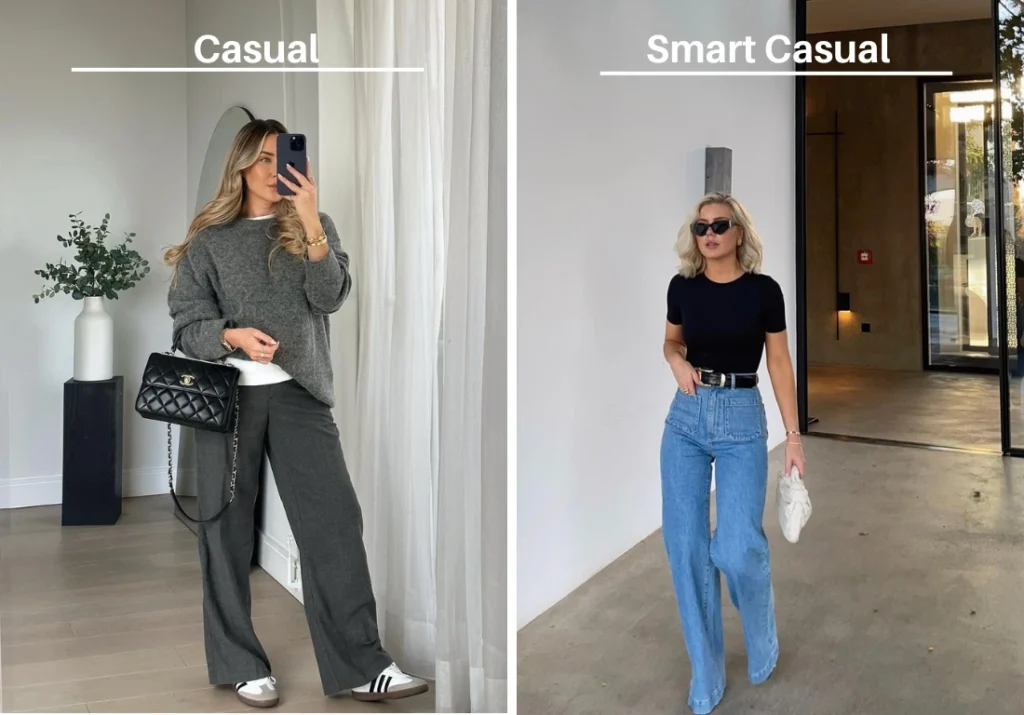
Understanding the nuances between casual and smart casual dress codes can be a game-changer in how you present yourself in different settings.
While this article focuses on the casual dress code, it’s helpful to know how it compares to other dress styles.
For a deeper understanding of various dress codes and what they really mean, including smart casual, business casual, and formal, check out our comprehensive guide: Understanding Types of Dress Codes: What They Really Mean.
Differences Between Casual and Smart Casual Dress Codes
Casual
This is the most relaxed dress code. It’s all about comfort and personal style. Think jeans, t-shirts, casual dresses, and sneakers.
Smart Casual
A notch above casual, this dress code is a blend of casual wear with more polished elements. It’s casual yet neat and put together.
Outfit Examples for Each Category
Casual Outfit
A pair of well-fitted jeans, a plain t-shirt, white sneakers, and a denim jacket. Accessorize with a simple pendant and a canvas tote bag.
Smart Casual Outfit
Swap the jeans for tailored trousers, the t-shirt for a blouse, and sneakers for loafers or ankle boots. Add a blazer, and choose a structured handbag to elevate the look.
Seasonal Adaptations in Casual Wear
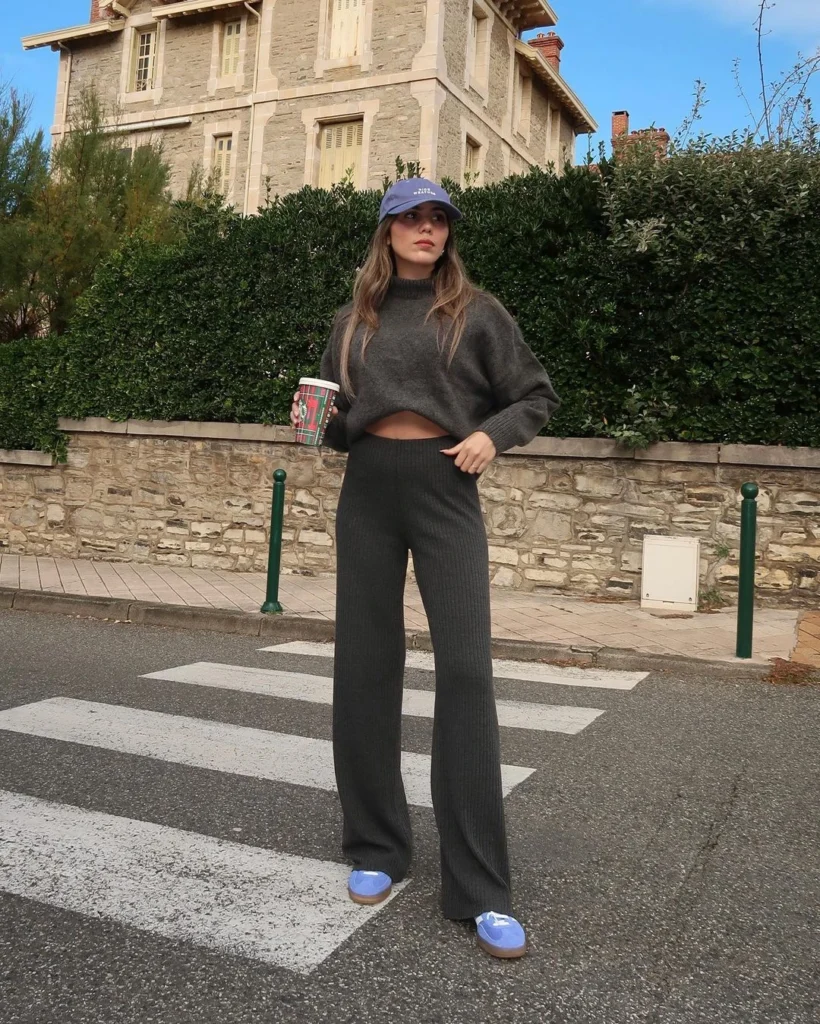
Dressing casually doesn’t mean wearing the same thing all year round. Each season brings its own vibe and adapting your casual wardrobe accordingly can keep you comfortable and stylish.
Adapting Casual Outfits for Different Seasons
Spring: Embrace lighter fabrics and pastel colors. Layer a light cardigan over a t-shirt for those cooler days.
Summer: Go for breathable materials like cotton and linen. Sundresses, shorts, and tank tops are perfect for staying cool.
Autumn: Incorporate earthy tones and layer up with light jackets or sweaters.
Winter: Focus on warmth with knitted sweaters, jeans, and boots. Don’t forget a cozy scarf and a beanie.
Layering Techniques for Transitional Weather
Layering is key during transitional weather. Start with a basic layer like a t-shirt or a blouse, add a sweater or a cardigan for extra warmth, and top it off with a jacket or a coat. This way, you can easily adjust your outfit as the day warms up or cools down.
Casual Dress Code for Different Occasions
Casual wear can be versatile enough to fit various settings, but it’s important to tweak your outfit to suit the occasion.
Adapting Casual Wear for Various Settings
Work: If your workplace has a casual dress code, opt for neat and unblemished pieces. Pair a blouse with chinos or a casual dress with a cardigan.
Social Events: Depending on the event, you can dress up or down. For a casual lunch, jeans and a stylish top work well. For a more upscale casual event, consider a dressier top and tailored pants.
Decoding Casual Wear for Various Settings
It’s crucial to gauge the environment and the occasion. What works for a casual day with friends may not be suitable for a work setting. Always lean towards a tidier, more put-together look when in doubt, especially in professional or formal settings.
Incorporating Personal Style into Casual Attire
Your casual wardrobe is more than just clothes; it’s a reflection of your personality. Infusing your individuality into casual outfits makes them uniquely yours.
Infusing Individual Personality into Casual Outfits
Personal Touches: Add elements that speak to you, like a vintage scarf, a quirky pin, or a favorite pair of colorful sneakers. These small touches can transform a basic outfit into something that showcases your personality.
Mix and Match: Don’t be afraid to mix different styles. Pair a classic blazer with a graphic tee, or wear bold jewelry with a simple dress. It’s all about creating a balance that reflects who you are.
Balancing Trends with Timeless Pieces
Timeless Basics: Invest in timeless pieces like a white tee, denim jeans, or a black dress. These are the building blocks of your wardrobe.
Trendy Elements: Add a few trendy items each season to keep your style fresh and current. This could be a seasonal color, a unique pattern, or a current style of shoe or bag.
The Balance: The key is to mix these timeless basics with trendy elements in a way that feels true to your style.
Sustainable and Ethical Casual Fashion
In a world increasingly aware of its environmental footprint, choosing sustainable and ethical fashion is a powerful way to make a difference.
Spotlight on Eco-Friendly and Ethical Casual Wear Brands
Eco-Friendly Brands: Look for brands that use sustainable materials, like organic cotton or recycled fabrics, and have ethical manufacturing processes.
Transparency: Brands that are open about their production processes and labor practices are often a good choice. They usually share this information on their websites or product tags.
Tips for Sustainable Fashion Practices
Quality Over Quantity: Invest in high-quality pieces that last longer, rather than constantly buying new items.
Care for Your Clothes: Properly caring for your clothes (like washing in cold water and air drying) can extend their life and reduce environmental impact.
Recycle and Donate: Instead of throwing away old clothes, recycle them or donate to charity shops. Many brands also offer recycling programs for their products.
Maintenance and Care for Casual Garments
Taking good care of your casual clothes not only keeps them looking great but also extends their lifespan. Here’s how to maintain your casual wardrobe effectively:
Best Practices for Care and Longevity of Casual Wear
Read Labels: Always check the care labels on your garments. They provide crucial information on washing, drying, and ironing.
Washing Tips: Wash clothes in cold water to preserve colors and prevent shrinking. Separate lights from darks to avoid color bleeding.
Gentle Drying: Avoid using high heat in dryers. Instead, air dry your clothes when possible. It’s gentler on fabrics and saves energy.
Immediate Attention to Stains: Treat any stains as soon as they happen. The longer a stain sits, the harder it is to remove.
Tips for Storage and Organization of a Casual Wardrobe
Folding vs. Hanging: Fold heavy items like sweaters to prevent them from losing their shape. Hang delicate items like dresses and shirts to avoid wrinkles.
Organize by Category: Keep your wardrobe organized by categorizing clothes – all t-shirts together, all jeans together, etc. This makes it easier to find what you’re looking for.
Seasonal Rotation: Rotate your wardrobe seasonally. Store off-season clothes in a cool, dry place to free up space and keep your current wardrobe manageable.
Inspiration and Fashion Icons in Casual Wear
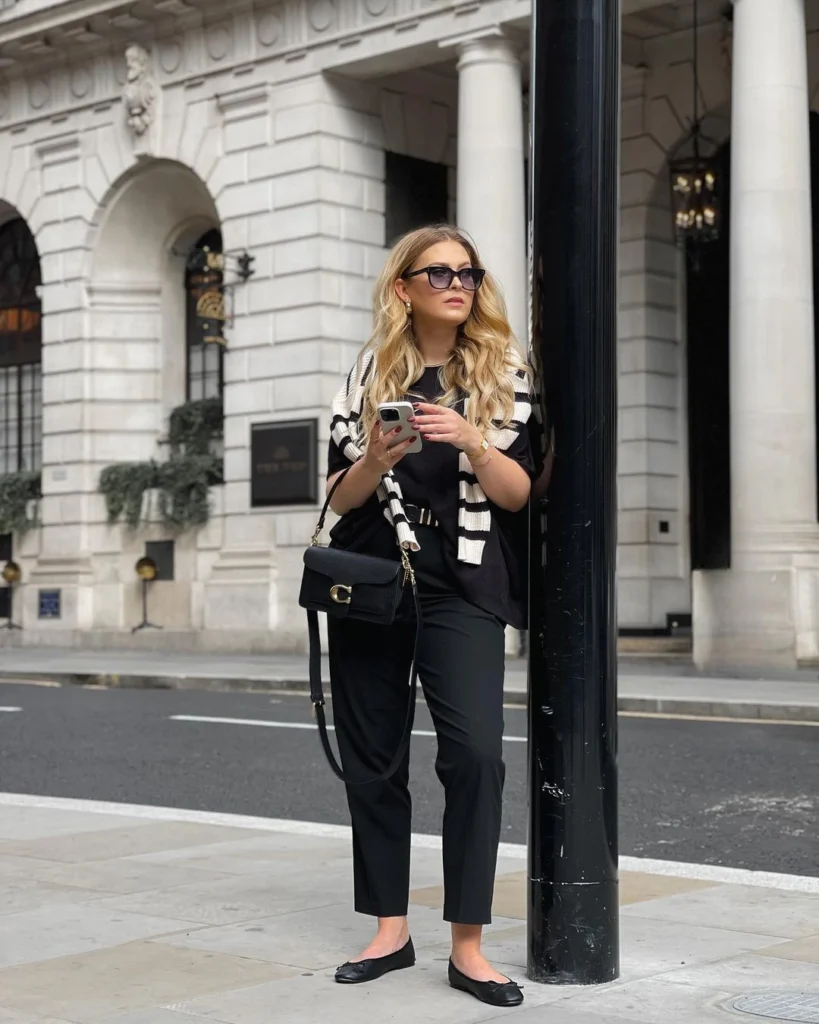
Looking to celebrities and influencers can provide a wealth of inspiration for your casual style. They often have access to the latest trends and can offer fresh ideas on how to style everyday pieces.
Highlighting Celebrities and Influencers with Notable Casual Styles
Celebrities: Look for celebrities known for their casual style. For instance, Jennifer Aniston’s classic and effortless look, or Zendaya’s trendy and youthful outfits.
Influencers: Fashion influencers on platforms like Instagram or YouTube often showcase accessible and relatable casual styles. They can be a great source of inspiration for everyday looks.
Resources for Style Inspiration
Fashion Blogs: Blogs are a treasure trove of style tips and outfit ideas. They often provide more detailed content, including how to style certain pieces or adapt trends to your personal style.
Magazines: Fashion magazines remain a classic source of inspiration. They not only highlight current trends but also offer advice on incorporating them into your wardrobe.
Social Media: Instagram and Pinterest are fantastic for visual inspiration. You can follow fashion accounts, save looks you love, and even create boards for different style ideas or occasions.
Conclusion
Mastering the casual dress code is about finding the perfect balance between comfort and style.
By incorporating key pieces, adapting to the seasons, and adding a touch of personal flair, you can create a wardrobe that’s not only practical but also uniquely yours.
Remember, the essence of casual wear lies in its versatility and ease. So, embrace these tips, make them your own, and step out in confidence, knowing you’re effortlessly embodying the casual chic spirit every day.
FAQ
What is the smart casual dress code for women?
Smart casual for women is a blend of professional and relaxed styles. It typically includes tailored pants or skirts, stylish tops, dressy flats or low heels, and refined accessories like a leather bag or elegant loafers.
How can women put together a smart casual outfit?
To assemble a smart casual outfit, mix classic pieces like blazers, dress pants, and button-up shirts with relaxed elements such as jeans or a casual tee. The key is to balance sophistication with comfort, ensuring the outfit is neither too formal nor too casual.
What are some common mistakes to avoid when dressing in smart casual attire?
Avoid overly casual items in smart casual attire, such as cargo pants, joggers, hoodies, mini-skirts, and graphic tees. Aim for a polished yet relaxed look, steering clear of extremes in either direction to maintain a professional yet approachable appearance.

